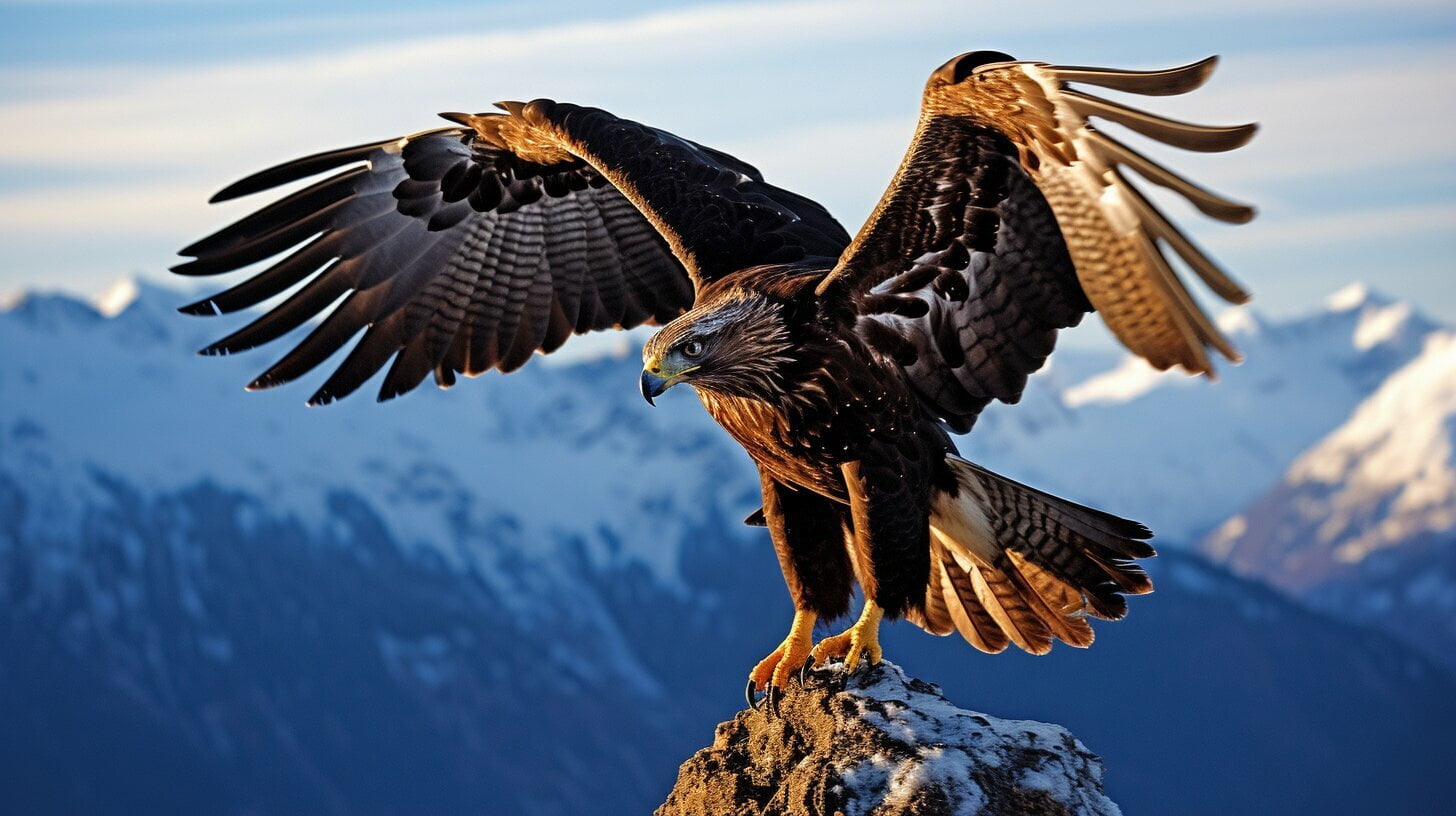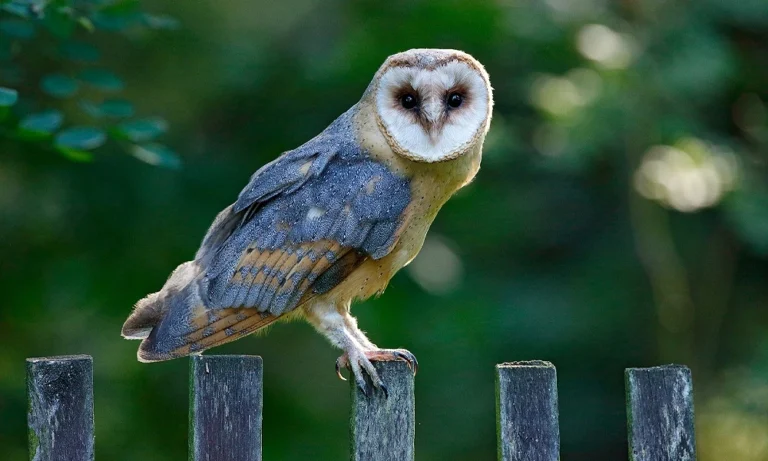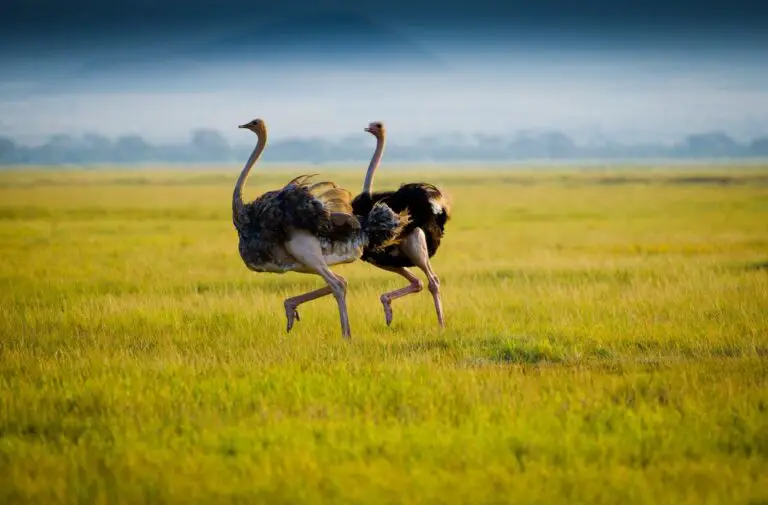If you’re an avid bird watcher or simply enjoy nature, you’ve likely come across falcons, hawks, and eagles during your outdoor adventures. While these birds of prey may seem similar at first glance, they each possess unique traits and characteristics that set them apart.
From their physical appearance to their hunting techniques, understanding the differences between falcons, hawks, and eagles is essential for any nature enthusiast. In this article, we’ll explore the various traits of these magnificent birds and highlight the key differences that make them stand out.
Key Takeaways:
- Falcons, hawks, and eagles are all birds of prey and raptors.
- Despite their similarities, falcons, hawks, and eagles have unique characteristics and behaviors that set them apart.
What are Falcons, Hawks, and Eagles?
If you want to understand the differences and similarities between falcons, hawks, and eagles, it’s important to start with their classification. All three birds are members of the raptor family and are considered birds of prey. This means that they hunt and kill other animals for food.
Habitat and Distribution
Falcons, hawks, and eagles can be found all over the world, from the Arctic tundra to the tropical rainforest. However, their specific habitat preferences vary depending on the species.
Falcons tend to prefer open habitats, such as grasslands, deserts, and coastal cliffs. They are also known for nesting on tall buildings and other man-made structures in urban areas. In North America, the peregrine falcon can be found nesting on skyscrapers in large cities such as New York and Chicago.
Hawks, on the other hand, are more adaptable to a variety of habitats. They can be found in forests, grasslands, deserts, and even in urban areas. Some species, such as the red-tailed hawk, are particularly common in North America.
Eagles tend to prefer large open areas near water, such as lakes, rivers, and coastlines. Bald eagles, for example, are commonly found near bodies of water in North America, from Alaska to Florida.
Physical Characteristics and Size
Falcons, hawks, and eagles are characterized by their sharp talons, hooked beaks, and powerful wings. While these birds share similarities in their appearance, there are distinct differences that set them apart.
| Bird | Plumage | Beak Shape | Size |
|---|---|---|---|
| Falcon | Short and pointy feathers | Notched and curved | Small to medium |
| Hawk | Broad and rounded feathers | Straight and sharp | Medium to large |
| Eagle | Large and broad feathers | Straight and hooked | Large to extra-large |
Falcons are the smallest of the three, typically measuring between 9-15 inches in length and weighing anywhere from 2-4 pounds. Hawks are slightly larger, ranging from 12-24 inches in length and weighing between 2-4 pounds. Eagles are the largest of the group, with some species growing up to 3 feet in length and weighing over 10 pounds.
Another key difference is their wing shape and size. Falcons have narrow, pointed wings that allow them to reach high speeds and perform impressive aerial acrobatics. Hawks have broader wings that provide better lift and maneuverability for hunting in wooded areas. Eagles have the widest wingspan of all, giving them the ability to soar for long periods and cover great distances while hunting.
Overall, falcons, hawks, and eagles are highly adapted and powerful birds with impressive physical characteristics that make them well-suited for their hunting lifestyle.
Wingspan and Flight Abilities
Falcons, hawks, and eagles are known for their impressive wingspan and flight abilities, which allow them to soar through the sky and swiftly catch their prey.
Among the three, eagles have the largest wingspan, with some species reaching up to 7 feet. Their wings are broad and sturdy, allowing them to soar for long periods without flapping. Hawks have a slightly smaller wingspan, ranging from 2 to 5 feet, with long and pointed wings that enable quick maneuvers and sudden dives. Falcons, on the other hand, have a relatively shorter wingspan of 2 to 4 feet, but their wings are built for speed and agility, allowing them to dive at incredible speeds of up to 200 miles per hour.
Each species’ wing structure and size contribute to their hunting techniques and overall flight performance. For instance, eagles use their large wingspan to fly at high altitudes, giving them a broad view of the landscape, which they use to locate their prey. Hawks, with their pointed wings and ability to hover in the air, can spot small prey from a distance and dive down to catch it. Falcons, with their impressive speed and diving abilities, are known for hunting birds, diving down on their unsuspecting prey from above.
Hunting Techniques
The hunting techniques of falcons, hawks, and eagles are as varied as their wing structures. Eagles typically catch their prey in mid-air, swooping down to grab it with their sharp talons. Hawks use their agility to catch prey on the ground or in trees, while falcons capture flying birds in daring dives and sudden attacks.
Interestingly, each species also has its own preferred prey. Eagles hunt for fish, mammals, and birds that are larger than themselves, while hawks prefer small mammals such as rodents, reptiles, and insects. Falcons, on the other hand, hunt primarily for other birds, including doves, pigeons, and even other raptors.
Overall, falcons, hawks, and eagles are exceptional hunters, thanks to their unparalleled wingspan and flight abilities. Their mastery of the skies makes them fascinating creatures to observe and study.
Hunting and Feeding Behaviors
When it comes to hunting and feeding behaviors, falcons, hawks, and eagles each have their own unique techniques and preferences.
Falcons are known for their impressive speed and agility in flight, using their powerful wings to chase down smaller prey in mid-air. Their diet consists mostly of birds, which they hunt by diving from great heights and striking with their sharp talons.
Hawks, on the other hand, have a more diverse diet that includes birds, small mammals, and reptiles. They are skilled at both hunting in the air and on the ground, using their sharp eyesight and powerful talons to capture their prey. Many species of hawks also employ a technique called “stooping,” in which they dive down at incredible speeds to catch their prey.
Eagles are the largest of the three and often hunt larger prey, such as rabbits, fish, and even other birds. They have sharp, curved beaks that they use to tear through their prey and powerful talons that can exert incredible force. Eagles are also known for their impressive eyesight, which allows them to spot prey from great distances.
Despite their differences in hunting techniques and preferred prey, all three birds of prey play a vital role in maintaining the balance of their ecosystems as apex predators.
Vocalizations and Communication
Falcons, hawks, and eagles use a variety of vocalizations and communication methods to convey important messages and warnings.
Eagles, known for their powerful calls, use a variety of vocalizations to communicate with their mates and young. They also use vocalizations to claim territories and warn off potential threats.
Hawks, on the other hand, are relatively quiet birds. They use short, high-pitched calls to communicate with their mates and alert other hawks to potential prey.
“Falcons are known for their distinctive calls. Their high-pitched, shrill cries are used to communicate with their mates and establish territories.”
Falcons are known for their distinctive calls. Their high-pitched, shrill cries are used to communicate with their mates and establish territories. They also use vocalizations to warn off potential dangers and signal to other falcons during a hunt.
Overall, the vocalizations and communication methods of falcons, hawks, and eagles are crucial for their survival and success as apex predators.
Breeding and Reproduction
When it comes to breeding and reproduction, falcons, hawks, and eagles have unique strategies that allow them to thrive in their respective environments.
These birds of prey typically mate for life, with courtship rituals consisting of aerial displays and mutual feeding. They build large and sturdy nests, usually on cliffs, trees, or man-made structures, where they lay their eggs.
| Bird | Nesting Habits | Raising Young |
|---|---|---|
| Falcons | Build shallow scrape nests on cliffs, buildings, or trees. | Both parents participate in raising the young, with the male doing most of the hunting. |
| Hawks | Build large stick nests on trees or man-made structures. | Both parents participate in raising the young, with the female doing most of the incubation. |
| Eagles | Build large stick nests on trees or cliffs, often using the same nest for multiple years. | Both parents participate in raising the young, with the female doing most of the incubation. |
After hatching, the young birds are cared for by both parents, receiving food and protection until they are ready to fledge. The amount of time it takes for the young to reach maturity varies between species, with eagles taking the longest at around five years.
Overall, falcons, hawks, and eagles have intricate breeding and reproduction practices that ensure the survival of their species and the continuation of their roles as apex predators in their habitats.
Habitat and Distribution
You’ll find falcons, hawks, and eagles in a variety of habitats across the world. While they may have some overlap in their distribution, each species has its own preferences.
| Bird | Habitat |
|---|---|
| Falcon | Open country, deserts, and coastal areas |
| Hawk | Forests, fields, and mountain ranges |
| Eagle | Mountains, coastlines, and large bodies of water |
Falcons are known for their ability to live in a variety of habitats, but they prefer open areas such as deserts, tundras, and coastal regions. Hawks, on the other hand, prefer living in forests, fields, and mountainous regions. Eagles tend to live in more remote areas such as mountains, coastlines, and large bodies of water.
Their choice of habitat has a significant impact on their hunting and feeding behaviors. For example, hawks that live in fields primarily hunt small mammals such as mice and rabbits, while hawks in forests tend to prey on birds and small reptiles. Eagles that live near shorelines primarily feed on fish, while those living inland hunt mammals like rabbits and squirrels.
It’s important to note that human activities such as deforestation and habitat destruction have had a significant impact on the distribution of these birds. Conservation efforts are ongoing to protect these species and their habitats.
Interactions with Humans
Falcons, hawks, and eagles have long been subjects of human fascination and interaction. Perhaps the most notable is falconry, an ancient practice of training birds of prey to hunt for humans. In the Middle Ages, falcons were highly valued and seen as a status symbol among the nobility. Today, falconry is still practiced in some parts of the world as a sport and a means of pest control.
These birds also hold significant cultural and spiritual importance in many societies. Eagles, for example, have been revered as symbols of strength and freedom and used as national symbols in many countries, including the United States. In Native American cultures, they are considered sacred animals and play prominent roles in their mythologies.
However, human activities have also posed significant threats to these birds. Habitat loss, hunting, and the use of pesticides have all contributed to declines in their populations. Many conservation efforts have been put in place to protect these birds, including bans on hunting, captive breeding programs, and habitat restoration projects.
It is important to remember that these birds are apex predators and play critical roles in their ecosystems. Their interactions with humans should be respectful and mindful of their status as wild animals.
Conclusion
In conclusion, falcons, hawks, and eagles are majestic birds of prey that share many similarities but also have unique differences in their physical characteristics, flight abilities, hunting and feeding behaviors, vocalizations and communication, breeding and reproduction, and interactions with humans.
These raptors play a critical role in the delicate balance of the ecosystem as apex predators, and their conservation is essential to maintain healthy ecosystems and biodiversity.
Whether soaring high in the sky or diving down at lightning speed to catch their prey, these magnificent birds never cease to captivate us with their beauty and power.
Next time you spot a bird of prey in the wild, take a moment to appreciate their presence and the important role they play in our natural world.
FAQ
Q: What are the differences between falcons, hawks, and eagles?
A: Falcons, hawks, and eagles are all birds of prey and belong to the raptor family. While they share some similarities, such as their predatory nature and sharp talons, there are notable differences in their physical characteristics, habitats, and hunting behaviors. Falcons are known for their exceptional speed and aerial hunting skills, hawks have a broader wing structure and tend to hunt from perches or through soaring, and eagles are recognized for their large size, impressive wingspan, and their ability to snatch fish from bodies of water.
Q: Where do falcons, hawks, and eagles live?
A: Falcons, hawks, and eagles inhabit various habitats across the globe. Falcons can be found in open areas such as deserts, grasslands, and coastal regions. Hawks are adaptable and can be found in a wide range of habitats, including forests, mountains, and urban areas. Eagles tend to prefer large, open spaces near bodies of water, such as rivers, lakes, and coastlines.
Q: How do falcons, hawks, and eagles differ in size?
A: Falcons, hawks, and eagles vary in size. Falcons are generally smaller, with a length ranging from 9 to 24 inches and a wingspan of 20 to 45 inches. Hawks can have a length of 18 to 26 inches and a wingspan of 36 to 60 inches. Eagles are the largest of the three, with a length of 28 to 40 inches and a wingspan of 72 to 96 inches.
Q: What are the flight abilities of falcons, hawks, and eagles?
A: Falcons are renowned for their exceptional flight speed and agility. They can reach remarkable speeds during their hunting dives or stoops. Hawks have a more diverse flight style, with some species known for their soaring abilities while others employ quick bursts of flapping flight. Eagles are powerful fliers, capable of soaring for long periods and covering large distances.
Q: What do falcons, hawks, and eagles eat?
A: Falcons, hawks, and eagles are carnivorous and primarily feed on small to medium-sized animals. Falcons often prey on birds, such as pigeons and small songbirds, but can also target small mammals and insects. Hawks have a varied diet that includes small mammals, birds, reptiles, and even insects. Eagles primarily feed on fish, but they are opportunistic hunters and may also consume small mammals, birds, and carrion.
Q: How do falcons, hawks, and eagles communicate?
A: Falcons, hawks, and eagles have distinct vocalizations for various purposes. They use calls to communicate with each other, mark territory, attract mates, and give warning signals. These vocalizations can range from piercing screeches and high-pitched whistles to melodious calls.
Q: How do falcons, hawks, and eagles reproduce?
A: Falcons, hawks, and eagles have similar breeding and reproductive habits. They typically form monogamous pairs, with both parents participating in nest-building and raising their young. They build nests on high perches or in trees, using sticks and other materials. Females lay one to four eggs, which are incubated by both parents. The young birds hatch after a few weeks and are cared for by their parents until they are old enough to leave the nest.
Q: What is the conservation status of falcons, hawks, and eagles?
A: The conservation status of falcons, hawks, and eagles varies depending on the species and region. Some species, particularly eagles, have faced threats such as habitat loss, pollution, and illegal hunting. However, many conservation efforts have been implemented to protect these birds and their habitats. International agreements and organizations work toward the conservation and preservation of these majestic birds.
Q: How have falcons, hawks, and eagles interacted with humans throughout history?
A: Falcons, hawks, and eagles have played significant roles in human culture and history. Falcons, in particular, have been trained for falconry, a traditional hunting method dating back centuries. They have also been symbols of power and prestige in various civilizations. Hawks and eagles have been depicted in art, literature, and mythology, often representing strength, freedom, and nobility. Today, these birds continue to capture the fascination and admiration of people worldwide.













